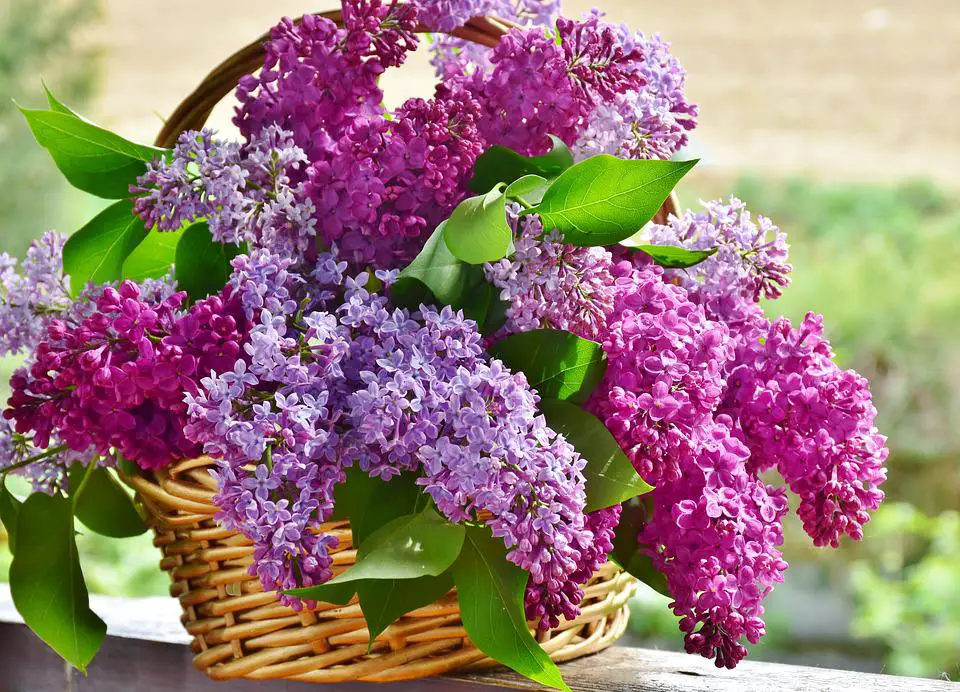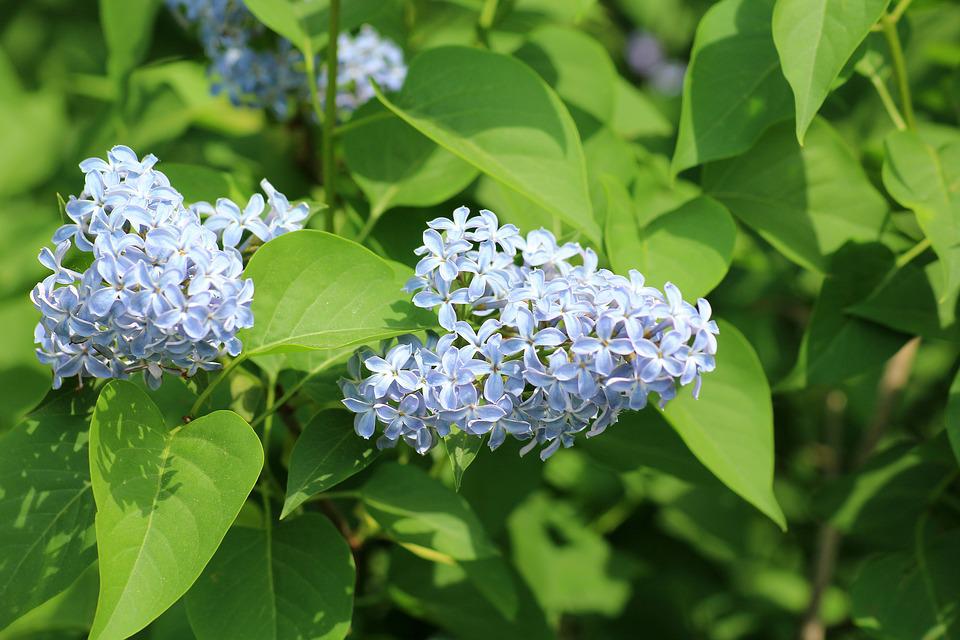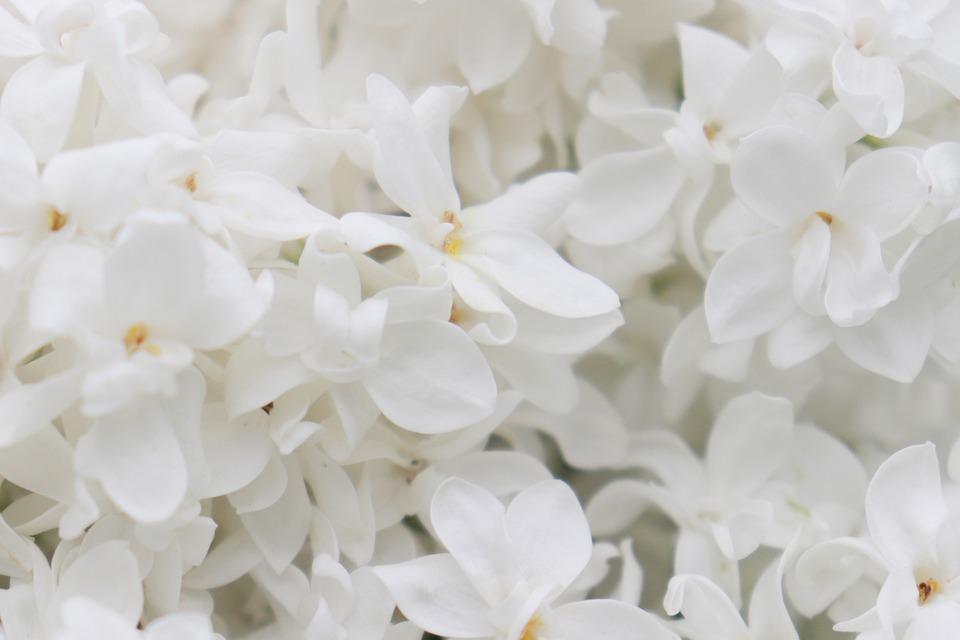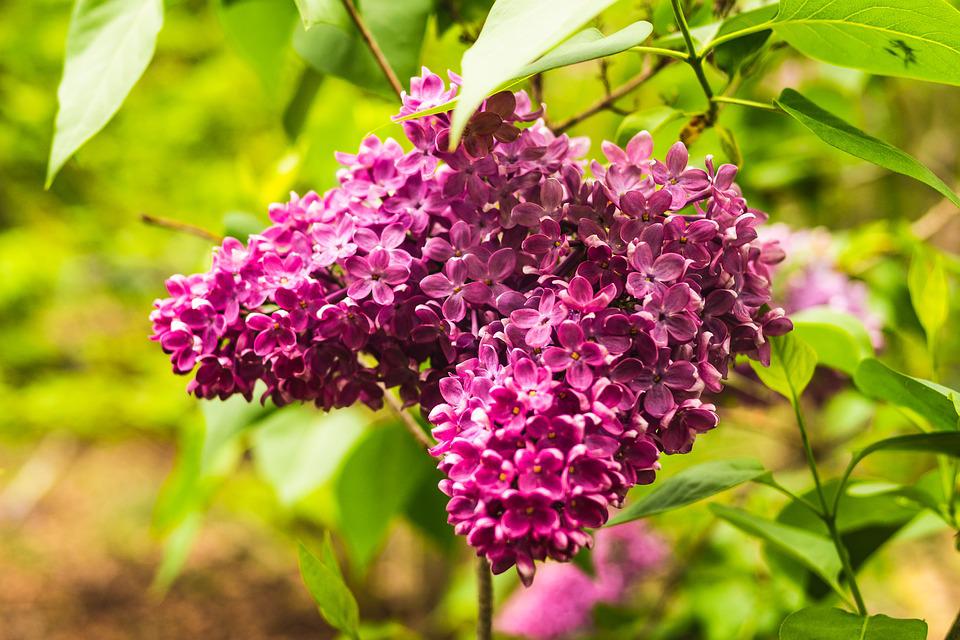
Last updated on May 21st, 2023 at 06:13 pm
Lilac plants belong to the olive or Oleaceae family and are native to woodlands of southeastern Europe and temperate regions of Asia. Lilacs were introduced in America by European colonists in the 1750s. They belong to the genus Syringa, and their scientific name is Syringa vulgaris.
Various varieties of lilacs grow as shrubs and small trees. There are twenty-five species of flowering lilac and about a thousand lilac cultivars. Some of the common lilac cultivars and hybrids are President Grevy, Beauty of Moscow, Bloomerang Dark Purple, Andeken, Ludwig Spath, Charles Jolly, Angel White, California Lady, Blue Boy, Lavender Lady, Wedgewood Blue, and Hungarian lilac.
Some varieties, like the common and Japanese lilac, grow into trees as tall as twenty to forty feet. Bicolor lilac features variegated purple and white flowers.
Most lilac varieties are deciduous shrubs with undivided green leaves. The common lilac has heart-shaped deep green or gray-green leaves opposite each other along the stem. Four petalled flowers bloom in large oval clusters. Flowers can be single or double in colors like light or deep purple, white, red, pink, and creamy yellow. Fruits look like leathery capsules.
The lilac flower finds its root in the Arabic and Persian words ‘lilaq’ or ‘lilak,’ which means flower. The scientific name Syringa vulgaris is connected to the Greek word ‘styrix,’ which translates into ‘pipe’ or ‘tube.’ The flowers got this name owing to the plant’s hollow stem. The genus was named in the mid-1700s by the Swedish botanist Carl Linnaeus.
What does the Lilac flower symbolize?
Like many other flowers, the lilac is also deeply rooted in Greek Mythology. According to Greek mythology, Syrinx was a beautiful nymph known for purity. Pan, the God of fertility, fields, and forests, who looked after the well-being of shepherds and flocks, fell in love with Syrinx.
To escape Pan’s affection and protect herself, Syrinx turned herself into a lilac shrub. Pan failed in his advances but located the lilac shrub. He cut some reeds from the shrub and created a panpipe, the first one of its kind.
Some people also connect the lilac to the Sanskrit word ‘nilah,’ which means ‘blue.’
In the language of flowers, the lilac flower symbolizes youth’s joy as the flower blooms in spring. It represents a fresh start, renewal, and also innocence. The flower also stands for confidence, bygone love, and romance.
Lilac blossoms also symbolize confidence in someone. That makes these flowers wonderful floral gifts for graduation or wishing luck on new ventures.
The Lilac flower’s meaning varies in different cultures. According to the old Celtic belief, lilac flowers had magical powers owing to their overpowering fragrance. In the Victorian era, lilac represented an old or bygone love. Widows often wore lilac flowers in remembrance of their lost husbands. During this era, lilac blossoms were also given to remind people of their first love.
Russians believed holding sweet-scented lilac flowers over a newborn child would bring lasting wisdom. In the United States, lilac flowers represent the ‘Hearty character’ of people.
Although lilac flowers are synonymous with many emotions and feelings, they are mostly connected to expressing love or affection.
All in all, the lilac flower symbolic meanings are:
- spring
- renewal
- confidence
- first love
- romance
- innocence
- purity
- beauty
- wonder
Meaning of the Lilac flower colors
Blue color

Blue lilac flowers bloom in soft, cool shades of blue. They are associated with tranquility and happiness. These blue flowers also symbolize a baby boy. Blue lilac blossoms have calming and therapeutic properties.
Purple color

Purple lilac flowers are associated with spirituality. Varieties of lilacs that bloom in shades of purple have the strongest scent. Lilacs bloom in light and dark shades of purple. Light purple lilacs represent first love and romance. The darker, richer shades of purple lilac are tied to royalty, regality, and nobility.
As the lighter shades of purple lilac represent first loves, the dark purple varieties are often symbolic of remembering somber anniversaries.
Magenta color

Magenta is a deep, rich tone of reddish-purple that is symbolic of passionate and unrestrained love. Magenta lilacs represent romantic love and the thrill of being alive.
White color

Like most white flowers, white lilac flowers symbolize innocence, sympathy, divinity, purity, honor, enlightenment, and new beginnings.
Pink color

Pink is not just for little girls. Pink lilac flowers represent love and friendship. They can be gifted to friends and partners to express admiration and confidence.
Interesting facts about the Lilac flowers
- Lilac plants are known as the ‘Queen of Shrubs’ due to their beautiful flowers.
- Lilacs are edible and are used in several foods and drinks.
- Due to the hard, dense wood, lilac wood is used for engraving and making handles for knives, and making musical instruments.
- Lilac has many medicinal properties. In different cultures, lilac flowers, foliage, and bark treat ailments like rheumatism, cold, toothache, mouth soreness, gastrointestinal issues, and wounds.
- Purple lilac is the state flower of New Hampshire.
- Lilac flowers are well-loved for their intoxicating fragrance, herbal value, and lovely colors. These sweet-smelling, attractive flowers are so popular that they are often grown as ornamental plants in gardens and parks.
- In aromatherapy, lilac oil is used to relax and infuse a sweet smell into a room.
- The strong-scented, four-petal lilac flowers are used in various cosmetics, lotions, perfumes, food, and soaps.
- The oldest lilac bushes on Mackinac Island date to the 1870s. During the flowering season, the town celebrates a Lilac Festival for ten days in the first two weeks of June. The tradition has been going on since 1949.
- Lilac flowers appear in spring and early summer and are associated with Easter in many cultures.
- Lilacs are hardy plants that can live for more than a hundred years.
How to grow Lilac flowers
Lilacs are one of the most carefree spring-blooming shrubs and have a beautiful, haunting aroma! To add these flowers to your garden, you should learn how to grow and care for lilac flowers.
- Plant the lilacs in rich, loamy soil with sharp drainage and a neutral pH.
- Grow lilac bushes in full sun for at least six hours of direct sunlight on most days.
- Water young bushes regularly to keep the soil lightly moist.
- Apply a balanced fertilizer, following label instructions.
How to care for Lilac flowers
- Once established and matured, only water the lilacs during periods of drought.
- Mulch around the shrub to retain soil moisture and suppress weeds that might compete with the lilac.
- Prune branches to thin out the growth for better air circulation and to keep the shrub’s height in check.
- Cut the oldest branches to the ground, as they won’t be strong flower producers anymore.
- Remove any weak or damaged branches.
Best time to gift Lilac flowers
Lilac flowers in lovely shades of blue, purple, pink, and white make wonderful floral gifts on many occasions. Their pleasing scent and elegant look make them extremely popular and desirable.
This flower in a single color or a mixed bouquet makes perfect anniversary gifts. For the 8th wedding anniversaries, lilacs are the official flowers to give.
Purple and magenta lilacs are expressions of love. They are great additions to wedding flower arrangements. Light blue lilacs say ‘pick-me-up,’ so choose them when the occasion is right! Blue flowers also symbolize commitment and trust.
Lilacs don’t bloom year-round. So, gift them when they are in season. These flowers make lovely gifts in spring and early summer on just about any occasion.
Conclusion
Lilac flowers have an extensive and fascinating history, with different meanings and symbols depending on the culture. These flowers have been used to symbolize various things throughout history, including love, innocence, new beginnings, and beauty. They are frequently connected with springtime and new beginnings.
Whether or not you understand their symbolic value, lilacs are a beautiful addition to any garden or bouquet.
If you want to know and learn more about flowers, we at PansyMaiden can help you. Check out our fun, easy-to-read, and informative flower-related content that you will surely enjoy!

